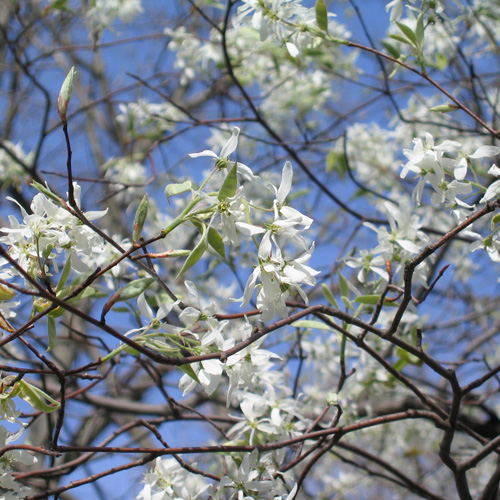Home Resources Gardener News reprints: Amelanchier: "Juneberry"
This article by Hubert Ling (NPSNJ horticulture) was published in Gardener's News without the photos. He is a regular contributing writer to Gardener's News. Photos by H & M Ling.
Juneberry
 What is a Juneberry? The Juneberry or Shad-bush is a shrub or small tree, 15-25’ tall, which is covered in pure white, shimmering, lightly fragrant flowers which appear in April even before the leaves. This shrub has good tasting berries which ripen in June, of course, when the Shad make their runs. The berries are blue-purple, the size of blueberries but they taste more like sweet black cherries or blackberries with a hint of apple or almond. In addition, the foliage turns a pleasant orange or rusty-red in fall which adds to its value in the home garden.
What is a Juneberry? The Juneberry or Shad-bush is a shrub or small tree, 15-25’ tall, which is covered in pure white, shimmering, lightly fragrant flowers which appear in April even before the leaves. This shrub has good tasting berries which ripen in June, of course, when the Shad make their runs. The berries are blue-purple, the size of blueberries but they taste more like sweet black cherries or blackberries with a hint of apple or almond. In addition, the foliage turns a pleasant orange or rusty-red in fall which adds to its value in the home garden.
Although Juneberries bushes are common in NJ, relatively few people have tasted them but there is an effort to raise them and introduce them to the general public; about a dozen small farms in NY State are engaging in commercial ventures. The commercial species is Amelanchier alnifolia or Saskatoon berry which grows naturally in Canada and North-Western US and produces more numerous berries than other species.
Our local common Juneberries are Amelanchier aborea and A. canadensis (both names are often used interchangeably). A. canadensis grows naturally on the Eastern seaboard from Canada to Georgia. It generally forms a multi-stemmed bush but a single stemmed tree will develop if you remove the suckers which tend to sprout up around the base of the plant. Juneberry has been widely used as an ornamental plant in informal settings. It grows well in a variety of soils but prefers a fertile, slightly acid to neutral soil in full sun or partial shade and is quite tolerant of damp soil.
Propagation is by use of the suckers. Seeds also grow well if they are planted a little green just before the seed coats have fully hardened or dried seed may be planted in late spring. After being subjected to summer heat and winter cold, germination is expected the next spring. The plant is not subject to any serious diseases or insect problems and is self-fertile. It is tolerant of wind so it will make a beautiful hedge or windbreak and it is sometimes used to create bonsai specimens.
Juneberries were much prized by Native Americans who took pains to cultivate and share good tasting strains. The natives ate the berries fresh, dried, or boiled in a broth with fat meat for feasts. Dried fruit was also mixed with corn-meal, used for pudding, and young branches were used to brew tea. In addition, a decoction of Juneberry, cherry, and young oak roots was drunk for dysentery and children who had pin worms were given a bath in Juneberry bark tea. Extracts from the inner bark were also used as disinfectant washes.
Today, some Amelanchier is eaten fresh but more is used for preserves, pies, muffins, and sometimes dried and used as raisons. Remember as with all wild fruit plants the quality of the fruit, from a human standpoint, varies greatly in different plants from great to really bitter; the safest bet to take a sucker from a plant known to produce great fruit or buy a large specimen with proven good fruit. Juneberries are packed with nutrients and are rich in antioxidants, calcium, copper, iron, and protein.
Since the plant is in the rose family, along with several popular fruits, Juneberry root stock can be used as a dwarfing root stock for apple and pear trees. This would be particularly useful in damp areas where apples and pears would normally not do well. Juneberry wood is dense, hard, and close grained. It is useful for tool handles and young, straight Juneberry branches were a favorite as arrow shafts.
Juneberry nectar is avidly sought by bees, butterflies, and other pollinators. The berries provide food of robins and bluebirds and 24 other animal species; birds are so enamored by the fruit that they will often completely strip a fully ripe tree of all berries. This fine if you are an animal lover but not so fine if you are a farmer. If you have the room give this beautiful, plant a try; the wildlife will thank you and so will your children.